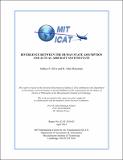| dc.description.abstract | Divergence is defined in this thesis as an inconsistency between the human operator’s assumption of the system state and the actual state of the system, which is substantial enough to have consequential effects on the outcome of the situation. The purpose of this thesis is to explore the concept of divergence and develop a framework that can be used to identify the consequential causes of divergence in cases involving human-system interaction.
Many recent aircraft accidents involve divergence between the crew state assumption and the actual system state. As aircraft systems and automation become more complex, it’s possible that the consequential effects of divergence, illustrated by these accidents, could become more prevalent due to the correspondingly more complex understanding that may be required by the crew to effectively operate the aircraft.
Divergence was explored as a concept by (1) understanding the previous literature related to divergence such as work on human error, human information processing, situation awareness, and mode awareness (2) developing a framework that can be used to understand possible causes of divergence, (3) illustrating use of the framework with accident case studies, and (4) discussing the implications of the findings of the case study analysis of divergence.
Human information processing of divergence was developed using the established human information processing literature including Wickens (1992), Endsley (1995), and Reason (1990). The framework highlighted the inputs to the human and represented human processing of this information in relation to formation of a state assumption. The process model was used to identify potential causes of divergence, which were hypothesized as human information processing failures affecting the human state assumption, and to evaluate the effects of those failures on downstream processes and the human state assumption. Eleven accident case studies involving automation mode confusion were conducted to evaluate divergence using the process model of divergence. Eight of the case studies involved auto-throttle mode confusion and the three remaining cases involved divergence in other automation systems that resulted in controlled flight into terrain. The industry implications of the findings of the case studies were then discussed. | en_US |
